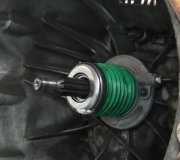Circuit Description
The Powertrain Control Module (PCM) controls the Torque Converter Clutch Solenoid Valve (TCC Sol. Valve) pulse width modulation (PWM). The solenoid controls the hydraulic fluid for Torque Converter Clutch (TCC) apply and release. When the TCC is applied, the engine is coupled directly to the transmission through the TCC. The TCC slip speed should be near 0.
If the PCM detects high torque convener slip when the TCC is commanded ON, then DTC P0741 sets. DTC P0741 is a Type B DTC.
Conditions for Setting the DTC
†No MAF DTCs P0101, P0102, or P0103.
†No TP DTCs P0121, P0122, or P0123.
†No VSS DTCs P0502, or P0503.
†No AIT ISS DTCs P0716, or P0717.
†No TCC Stuck ON DTC P0742.
†No TFP Val. Position 5w. DTC P1810.
†No TCC PWM Sol. Valve DTC P1860.
†The engine has been running for more than 5 seconds.
†The engine is not in fuel cut off.
†The TFP Val. Position Sw. Indicates D4.
†The transmission gear ratio indicates 2nd, 3rd, or 4th gear.
†The throttle angle is greater than 8 degrees.
†The transmission fluid temperature is -18 - 130°C (0 - 266°F).
†Delivered torque is between 43 - 202 N.M (32 - 150 lb ft).
†The TCC Sol. Valve is commanded ON at maximum duty cycle.
†The TCC slip must not exceed torque limits.
Action Taken When the DTC Sets
†The PCM illuminates the Malfunction Indicator Lamp (MIL).
†SERVICE ENGINE SOON, SERVICE TRANSMISSION displays on the Driver Information Center (DIC).
†The PCM inhibits TCC engagement.
†The PCM inhibits 4th gear if the transmission is in hot mode.
†DTC P0741 is stored in the PCM history.
Conditions for Clearing the MIL/DTC
†The PCM turns OFF the MIL after three consecutive trips without a failure reported.
†A scan tool can clear the DTC from the PCM history. The PCM clears the DTC from the PCM history if the vehicle completes 40 warm-up cycles without a failure reported.
†The PCM cancels the DTC default actions when the fault no longer exists and the ignition is OFF long enough in order to power down the PCM.
Diagnostic Aids
†Inspect the transmission fluid level.
†The transmission may be in hot mode. Inspect the transmission fluid lines to the radiator. The lines may be pinched, plugged or twisted
Test Description
The numbers below refer to the step numbers on the diagnostic table.
2. This step inspects the transmission fluid to ensure that it is at the proper level.
5. This step verifies that the TCC engages when commanded ON by the scan tool.
Codes never idnetify bad parts just failed system.
This the chart that needs to be followed to determine the failure
Roy
SPONSORED LINKS
Saturday, March 2nd, 2013 AT 4:04 PM



